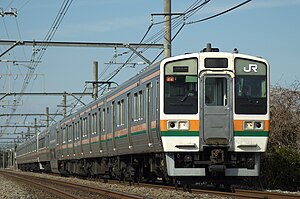211 series
| 211 series | |
|---|---|

JR East 211 series set on a Takasaki Line service in May 2007
|
|
| In service | 1985–Present |
| Manufacturer | Hitachi, Kawasaki Heavy Industries, Kinki Sharyo, Nippon Sharyo, Tokyu Car Corporation |
| Replaced | 113 series, 115 series |
| Constructed | 1985–Present |
| Scrapped | 2012–Present |
| Operator(s) |
|
| Specifications | |
| Car body construction | Stainless steel Steel (JR-West version) |
| Car length | 20,000 mm (65 ft 7 in) |
| Width | 2,950 mm (9 ft 8 in) |
| Doors | 3 pairs per side |
| Maximum speed | 110 km/h (JR-West 120 km/h) |
| Traction system | Resistor control + field system superimposed field excitation control |
| Acceleration | 1.7 km/h/s |
| Electric system(s) | 1,500 V DC |
| Current collection method | Overhead catenary |
| Bogies | DT50B (motored), TR235B (trailer)(211-0/1000/2000/3000 series) TR235G (SaRo 213/SaRo 212) C-DT56 (motored), C-TR241 (trailer) (211-5000/6000 series) WDT50B (KuMoRo 211/MoRo 210) |
| Multiple working | 311/313 series |
| Track gauge | 1,067 mm (3 ft 6 in) |
The 211 series (211系 Nihyaku-jūichi-kei?) is a suburban electric multiple unit (EMU) train type introduced in 1985 by Japanese National Railways (JNR), and currently operated by East Japan Railway Company (JR East) and Central Japan Railway Company (JR Central) and formerly also operated by West Japan Railway Company (JR-West) in Japan.
The 211 series was developed by JNR to replace older 113 series and 115 series trains. The 211 series incorporated regenerative brakes and stainless body construction.
...
Wikipedia
